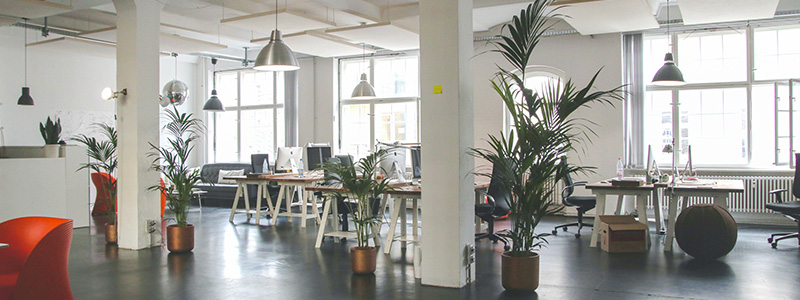FLEX OFFICE: WHEN FLEXIBILITY COMES TO THE OFFICE

New way of working, the flex office or flexible office is on the rise. This organization mode is more and more used by French companies.
According to OpinionWay, more than a third of employees in the service sector work in a flex office or similar space. The concept also addresses issues of cooperation and productivity between workers. Focus on the subject.
An undeniable revolution, the flex office organization is a concept that is increasingly appealing to self-employed workers seeking a certain quality of life at work. A dynamic organization, where the concept of assigned space has been completely removed from everyday life to make way for a more collaborative workspace.
In a dynamic space, each employee manages a workplace according to his or her needs. A development of collaborative spaces that obviously involves new work rules for employees.
#1. Flex office: The result of a changing world of work

Nomadic and self-employed, workers are more likely to choose to leave their workstation free. For some time now, offices have been emptying. Part-time teleworking, meeting outside, sick leave, leave are all reasons to change and improve workspaces.
In particular, the boom in digital usage has had a major impact on the growth of the flex office. With the digital revolution, it is now possible to access work tools anywhere and anytime. So why stay in a fixed office if you can enjoy greater freedom?
Desk sharing or flexible office can be adapted to the needs of each employee. In this type of organization, the space is to respond to a specific need: customer meeting, brainstorming session, reporting etc.
If you need for tasks such as reviewing the accounting for example, we recommend you choose an individual office. If, on the other hand, you need to exchange ideas, opt for places suitable for sharing such as coworking areas, where it is easy to ask a colleague for help.
In a flex office, each employee is free to choose the working environment in which he or she wishes to work. Workspaces can be rented on a daily, hourly or monthly basis depending on need, and the lease can be terminated at any time. Specialized companies also add numerous services to the lease, to work in optimal conditions.
#2. Understanding the flex office concept: the future offices?
The flexible office or flex office refers to the non-assignment of a dedicated office to each worker. In a flex office, the worker is therefore free to choose a vacant position to carry out his or her tasks. Once his work is done, instead of storing his laptop and work stuff in his office, he will place them in his locker.
The flex office is an alternative set up to rectify the mistakes of the open space, which hinders concentration and prevents isolation. The craze for this type of professional space layout and design allows access to airy trays with trendy and functional furniture, with dedicated rooms for isolation or meeting.
According to his mood or his needs, the worker has different types of work spaces at his disposal. There is a multitude of different spaces and decorations depending on the location and the company. These spaces meet a very clear specification, an open space with flex desk, isolation areas, a place to relax and of course meeting rooms.
#3. Desk sharing, an advantageous solution

Flex office also means implementing a certain amount of space optimization. Workstations are usually expensive because they are only occupied half of the time. The flex office is a solution that reduces the real estate cost per employee, and allows you to benefit from free space in order to design a collaborative place.
Removing unused workstations to redistribute them by varying the work environment and offering useful services to workers is a perfectly economical solution. The idea is to allocate workspaces with fewer posts than the number of employees.
Flex office is also an alternative that encourages creativity and fulfillment. Not only does this type of layout break the routine in the office, it also encourages workers to create and maintain more team bonds while experiencing recent work processes.
The synergy generated by the employees encourages creativity, agility and productivity. With this type of office, the worker is less constrained. This offers a multitude of solutions that can be adapted to everyone: teleworking, different work environments and others. In short, the quality of working life increases considerably.
#4. Organizing and anticipating the flex office

Flex office is attractive to many companies. However, the layout must be done with care. Many companies have already turned to this trendy and practical solution. For a functional space, anticipate the material needs of the workers: smartphone and computer. Obviously, you need to know the physical needs of the place such as a fast and efficient Internet network, a reservation process for meeting rooms, a file storage system etc.
These new spaces also require a transition in management and work modes. The company must ensure the remote management of teams, revitalize the professional space, and ensure that the employee retains a sense of belonging to the company. More specifically, care must be taken not to let one’s team isolate itself and forget its place within the company.
Flex office is also synonymous with freedom and autonomy. Establishing a management style based on trust and not control is essential. To be accompanied by professionals is one of the solutions to succeed in this step.
As a specialist in the rental of flexible workspaces, Choose and Work accompanies you in this process.
